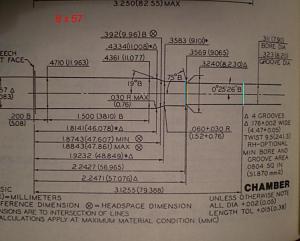No Larry, I'm not a guru, I just like to post accurate info if I have that information available. I design bullets to fit the throats of chambers so, I'm familar with chamber design. I also design my own chambering reamers for the rifles that I build.
So people don't get confused regarding a rifles throat. I'll do my best to explain it.
The throat is everything from the end of the case mouth, to where the leade brakes through the lands in the rifling. I've denoted the Throat by the blue lines that you see in the following drawings.
A freebore (shown in the 6.5 Rem Mag drawing) starts at the end of what Larry calls "case mouth taper" and is almost always a parallel cylinder of what ever length the designer thinks would be optimum for support, alignment and to set the proper COAL. I've denoted the freebore by the red lines.
One other use of it is to retard pressure build up, as in the case of the Weatherby cartridges. His freebore is usually much longer for that reason than other rifle chambers.
For clarification, the the leade can make up the entire throat of a rifle, as in the case of the 30/30, 32 Win Spec. and 38/55. Thoughs chambers start their throat at the end of the case mouth, with a single, continuous angle that transitions all the way through the lands.
Now the leade as depicted in most other chambers is a angular cut that can start at the end of the case mouth transition angle or can start at the end of the freebore, in either case, it cuts all the way through the lands and can even have multiple angles, as in the case of the 303 British. This I have depicted by yellow lines. For the 8 x57, the yellow line at the end of the leade and at the end of the throat is the same with the yellow drawn through the blue line.
If you measure the 8 x 57's leade, you'll find it to be 2.72 calibers long.
I hope this is helpful in explaining the throat and if you ever have a reamer made for yourself, either chamber, neck and throat or just a throating reamer, these are the terms the reamer maker will be looking for.
Frank


|
   
   
|


|





 Reply With Quote
Reply With Quote










